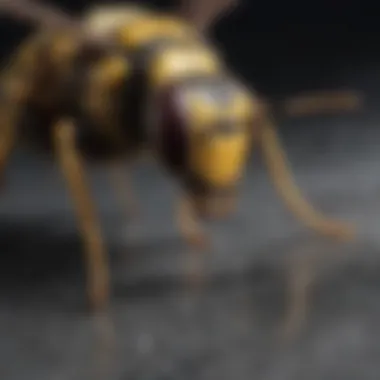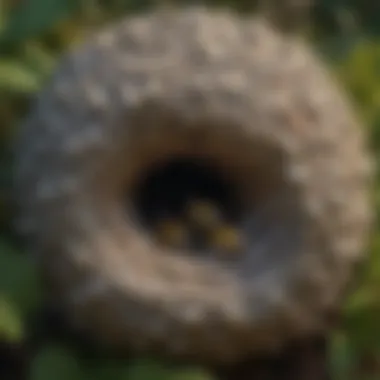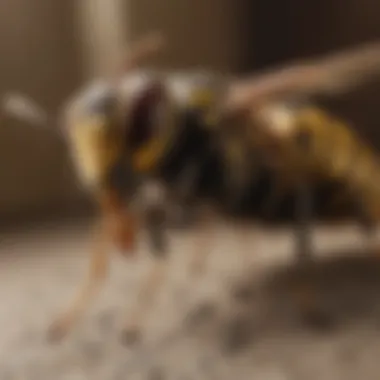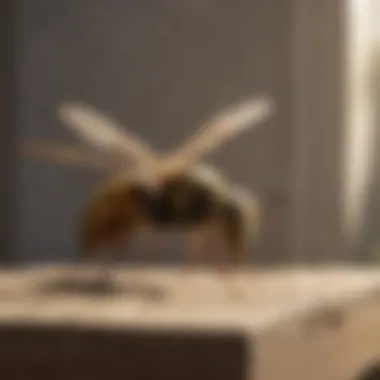Effective Strategies for Dealing with Wasps Indoors


Intro
Dealing with wasps that invade residential spaces can be a challenging endeavor. Homeowners need to recognize the importance of addressing these pests quickly and effectively. This guide will focus on various aspects of wasp interactions within homes, emphasizing identification, prevention, and treatment strategies.
Understanding how to recognize wasps and their behaviors is essential for preventing and managing infestations. Households that face frequent encounters with these stinging insects must examine their living spaces critically and take proactive measures.
Pest Identification
To manage wasps effectively, the first step is accurate identification. Wasps come in different species, each with specific characteristics and behaviors. Two common types that might be found indoors are the yellow jacket and the paper wasp.
Yellow jacket: These insects are small, about half an inch long with distinct yellow and black stripes. They are aggressive and often nest in wall cavities or underground.
Paper wasp: Slightly larger, they have elongated bodies and are brown with yellow markings. These wasps create umbrella-shaped nests, often located in sheltered places, such as overhangs or under eaves.
Signs and Symptoms of Infestations
Signs that wasps have made themselves at home include:
- Sightings: Regular sighting of wasps entering and exiting from a specific area.
- Nests: Observing nests attached to buildings, trees, or fences.
- Swarming Behavior: Sudden increases in wasp presence can indicate a nearby nest.
Identifying wasps early can help prevent an infestation from escalating into a safety hazard.
Prevention Strategies
Once wasps have been identified, a variety of prevention strategies can help minimize their intrusion.
Home Maintenance Tips for Pest Prevention
- Seal Entry Points: Regularly inspect your home for gaps or cracks. Use caulk or weather-stripping to seal off areas where wasps may enter.
- Remove Food Sources: Keep outdoor trash bins sealed and avoid leaving food uncovered outside, especially during warmer months.
- Trim Vegetation: Wasps are attracted to flowers and overgrown shrubs. Regular landscaping maintenance can deter them from nesting nearby.
Natural Deterrents and Barriers
- Vinegar Traps: A mix of vinegar and sugar can attract and trap wasps.
- Decoy Nests: Hanging a decoy nest may deter new wasps from nesting, as they typically avoid areas where other colonies are established.
Treatment Options
If prevention methods are insufficient, treatment becomes necessary. Various options exist, each with a different approach.
Overview of Chemical vs. Natural Treatments
Chemical treatments include insecticides specifically designed for wasps, while natural options range from essential oils to home-made traps. Consider safety and environmental impact when selecting a treatment type.
Step-by-Step Guides for DIY Treatments
- Use Traps: Fill a bottle with a mixture of water, sugar, and dish soap. Cut the top off the bottle and invert it into the bottom. This trap lures and drowns wasps.
- Natural Sprays: Mix water with peppermint or clove oil. Spray this mixture directly on the nests or areas where wasps are active.
- Home Insecticides: For severe infestations, consider a commercial wasp spray, ensuring to follow safety instructions carefully.
Understanding these strategies enhances the ability to manage wasps effectively within residential environments. Homeowners should feel equipped to confront and alleviate wasp-related challenges, making their living spaces tranquil and safe.
Understanding Wasps
Dealing with wasps requires an understanding of their biology and behavior. The significance of comprehending wasps lies in the ability to identify their presence and minimize potential risks in the home. A detailed knowledge of wasps can aid in the selection of appropriate prevention strategies and removal techniques. It's essential for homeowners to recognize the importance of this topic, as effective management of these pests can lead to a safer and more comfortable living environment.
Biology and Behavior of Wasps


Wasps belong to the order Hymenoptera, which also includes bees and ants. They have a slender body, with a narrow waist and two pairs of wings. Most wasps are not aggressive; their behavior is often linked to nest protection and foraging for food. Understanding their life cycle is integral. Wasps begin as eggs, which develop into larvae and finally mature into adults. They play an essential role in ecosystems by controlling pest populations and pollinating plants.
Wasps are social insects, forming colonies, or can be solitary. Social wasps live in large groups, typically found in nests made of paper-like material they create by chewing wood fibers mixed with their saliva. Solitary wasps, however, usually do not form such colonies and often have their burrows or cocoons.
Common Species Found in Homes
There are several wasp species that homeowners might encounter. Each species has unique behaviors and habitat preferences.
- Yellow Jackets: These are some of the most common wasps found in homes. They are highly aggressive and can become a problem during late summer and early fall. They build their nests in the ground, in walls, or inside homes.
- Paper Wasps: Recognizable by their long legs and umbrella-shaped nests, paper wasps are less aggressive than yellow jackets. They may nest under eaves or on porch ceilings.
- Hornets: Known for their larger size, hornets are a type of social wasp. Their nests can be found in trees or shrubbery around the home. Their stings can be painful but they tend to be less aggressive unless provoked.
- Cicada Killers: These large solitary wasps target cicadas. They often dig burrows in sandy or loose soil and are usually harmless to humans.
Awareness of these common species is crucial for effective management and control. Knowing what type of wasp is present can guide appropriate responses and methods for safely removing them from your living spaces.
Recognizing Wasp Infestations
Recognizing wasp infestations is a crucial step in managing these insects effectively. If left unchecked, wasps can turn from an occasional annoyance into a significant problem in a household. Early identification helps in minimizing risks, not only to the residents but also to pets. Knowing the signs of wasp activity can assist in timely interventions, which is essential, especially in late summer when their populations peak.
Signs of Wasp Activity
The first step is to observe specific signs that indicate wasp activity in your home. Here are several indicators to look for:
- Increased Wasps: Spotting more than a few wasps around your home may suggest an infestation. Pay attention to areas such as porches, yards, and windows where they are commonly seen.
- Buzzing Sounds: A constant buzzing noise can indicate the presence of a wasp nest nearby. If you hear this sound frequently, it could be a sign of a larger group of wasps.
- Nests: Recognizing the physical nests is crucial. They are typically made from a paper-like material created by the wasps chewing wood fibers mixed with their saliva. Nests can be found in sheltered locations like attics, eaves, or even in trees within the yard.
- Increased Aggression: As a nest grows, wasps can become more defensive, especially if someone approaches their territory. Being chased away or experiencing aggressive behavior from wasps indicates they are protecting a nest.
By being aware of these signs, homeowners can take appropriate measures before the situation escalates.
Identifying Wasp Nests
Identifying wasp nests accurately is vital for effective management. Once you suspect an infestation, locating the nest becomes your priority. Here are some tips on how to go about it:
- Look for Flight Patterns: Wasps tend to fly back and forth from their nests. If you see them entering and exiting a particular spot repeatedly, it is worth investigating further.
- Search Common Locations: Nests are often found in hidden areas such as attic spaces, under eaves, inside wall cavities, or even underground. Check these locations carefully.
- Observe Behavior at Dusk: Wasps are less active during the evening, making it an ideal time to observe potential nest locations without facing their aggression. Consider using a flashlight for better visibility.
- Check for Soft Areas on Walls: In some cases, like with yellow jackets, nests can be built in wall cavities. If you notice a soft spot on an exterior wall or a buzzing sound from inside, it may indicate a nest.
Recognizing and identifying wasp infestations can significantly ease the process of removal and prevention. When interventions are timely, not only is the household safer, but also the local ecosystem is respected by managing pest populations responsibly.
Risk Assessment
Understanding the risks associated with wasps is crucial for any homeowner. Wasps can pose serious threats, not only due to their aggressive behavior but also because of possible allergic reactions to their stings. It’s essential to assess the risks before engaging in any management or removal strategy, as this can help prioritize safety and guide effective actions.
Understanding the Dangers of Wasps
Wasps can be territorial and more aggressive than bees. Their stings can be painful and, in some cases, may lead to serious health complications. Wasps are particularly dangerous when their nests are disturbed, as they swarm to defend their territory. Here are some dangers associated with wasps:
- Physical Injury: Their stings can cause significant pain, and multiple stings can result in severe injurious outcomes.
- Allergic Reactions: A substantial number of individuals may experience allergic reactions, which can be life-threatening. Understanding this aspect is critical for risk management.
- Increased Aggressiveness: Certain species of wasps become more aggressive in late summer and fall, when food sources diminish. This can increase the likelihood of encounters inside the home.
Knowing these dangers allows homeowners to take proper precautions and prepare for potential encounters. Early identification of wasps can minimize the risk of being stung.
Assessing Allergic Reactions
Identifying if anyone in your household has a history of severe allergic reactions is key. Even if no one has been stung before, an unexpected reaction can occur. Signs of allergic reactions to wasp stings include:
- Hives or Rash: This may occur around the sting site or spread over the body.
- Swelling: Particularly in the face, throat, or tongue can impede breathing.
- Breathing Difficulties: Shortness of breath or wheezing need immediate medical attention.
- Anaphylaxis: This is a severe, potentially life-threatening condition requiring emergency care.
If you suspect an allergic reaction, it's advisable to consult a medical professional. Ensuring that an epinephrine auto-injector is accessible for those at risk can be a crucial preventative measure.
"Prevention is always better than cure." Assessing the risk allows you to take preemptive steps, which is more effective than reactive measures.
In summary, understanding the dangers of wasps and assessing allergic reactions helps create a safer environment in the home. This proactive approach is necessary for all families, especially those with allergy-prone individuals.


Prevention Strategies
Preventing wasps from invading your home is crucial for maintaining a safe and comfortable living environment. Effective prevention strategies can greatly reduce the likelihood of wasp infestations, minimizing the need for drastic removal measures. By addressing entry points, food storage, and landscaping, homeowners can create an unwelcoming space for these pests.
Securing Entry Points
Securing entry points to your home is the first line of defense against wasps. Wasps can enter through small openings, such as gaps around windows, doors, and vents. It is essential to inspect these areas regularly. Use weather stripping to seal gaps, and ensure screens on windows and doors are intact.
- Inspect doors and windows for gaps
- Utilize caulk or spray foam insulation to fill gaps
- Ensure your home’s foundation is intact, looking for any cracks
By taking these precautions, you drastically limit the areas through which wasps can access your home.
Proper Food Storage Practices
Proper food storage is another vital aspect of wasp prevention. Wasps are attracted to food sources, especially sweet substances and protein sources. To minimize this risk, consider the following steps:
- Always keep food covered, particularly when dining outdoors
- Store trash in sealed containers and dispose of it regularly
- Clean up spills and crumbs promptly
These actions not only discourage wasps but also support overall hygiene in your home. The less accessible food there is, the less likely wasps will linger.
Landscaping Considerations
Landscaping can also influence wasp activity around your home. Certain plants, like blooming flowers, can attract these pests. Opt for plants that are less appealing to wasps. Additionally, keeping your yard tidy can help.
- Trim back overgrown vegetation and shrubs
- Remove fallen fruit from trees promptly
- Avoid leaving pet food outside
A well-maintained yard not only looks appealing but also acts as a barrier against unwanted pests.
In summary, implementing these prevention strategies can effectively minimize the chances of wasps invading your living space. Being proactive now will save you from potential chaos later.
Effective Removal Techniques
Effective removal techniques are a critical aspect of managing wasp infestations in homes. Understanding when to act and how to execute removal can mean the difference between a safe environment and a hazardous one. The techniques employed not only need to be effective but also safe for both occupants and the ecosystem. Employing the right method minimizes the chance of stings and potential allergic reactions, making it paramount for homeowners to be well-informed.
When to Contact Professionals
Determining when to contact professionals for wasp removal is essential. If a nest is discovered in a location that is hard to access, such as high in the eaves or inside walls, professional intervention is often the safest option. Moreover, if anyone in the household has a history of severe allergic reactions to stings, contacting experts should be a priority. Their experience ensures that removal is conducted safely, and they can assess risks that an untrained individual might overlook. It's often wise to seek out pest control services that are certified and insured. Their expertise in handling various species and knowledge of local regulations can make a significant difference.
DIY Removal Methods
For those who choose to undertake wasp removal themselves, several methods can be effective, provided safety is prioritized.
- Protective Gear: Always wear long sleeves, pants, gloves, and a mask to safeguard against stings.
- Timing: Execute removal at dusk or after dark when wasps are less active.
- Water Drenching: A simple method involves soaking the nest with water. This can disorient the wasps and may kill them. Use a hose with a spray nozzle to reach the nest from a safe distance.
- Soap and Water Solution: Mixing dish soap and water can also be effective. It coats the wasps, suffocating them.
However, these methods require caution. If the situation seems overwhelming or if the nest is large, it may be best to reconsider and seek professional help.
Using Traps and Baits
Using traps and baits can be an effective approach to manage wasp populations without direct confrontation. Various types of traps can be purchased or made at home:
- Commercial Traps: Many stores offer wasp traps designed to lure and catch these pests. They usually contain attractants that lure wasps inside, trapping them.
- Homemade Traps: A simple trap can be made from a plastic bottle. Cut the top off and invert it into the base, adding sugar water or fruit juice as a bait.
- Baits: A mixture of protein and sugar can attract wasps. Place it away from living areas, encouraging them to feed away from human activity.
Essentially, these traps not only reduce the immediate threat but also help monitor wasp activity over time. Regular checks will ensure traps are effective and can alert homeowners to any return activity.
Post-Removal Considerations


Once the immediate threat of wasps has been addressed, the importance of post-removal considerations becomes paramount. This stage ensures that the situation does not revert, securing both safety and comfort in one’s living space. Failing to monitor and implement proper strategies after removal can lead to the unwelcome return of these pests. The focus here is on two critical areas: monitoring for return activity and implementing long-term solutions.
Monitoring for Return Activity
After wasps are removed, it is vital to monitor the area for any signs of return. Ongoing vigilance can significantly help in early detection of any new nests forming or wasps re-entering the home. Key strategies include:
- Regular Inspection: Check the areas where nests were located or where activity was noted. Examine eaves, attics, and other potential nesting sites regularly.
- Noticing Behavioral Changes: Pay attention to any wasp activity around food sources or near entry points. This can often signal a new nesting attempt.
- Use of Traps: Placing wasp traps near the prior nest location might catch returning wasps and provide insight into their activities.
By proactively monitoring, homeowners can address any new infestations promptly, reducing the likelihood of more significant problems down the line.
Implementing Long-Term Solutions
Long-term solutions are essential to minimize the risk of wasps returning. Addressing the conditions that attract these pests is crucial. Consider these approaches:
- Seal Entry Points: Inspect and seal up gaps and cracks where wasps may enter. Pay close attention to window frames, doors, and vents.
- Proper Waste Management: Secure garbage and compost. Make sure these containers are tightly sealed and not attracting pests.
- Maintain Cleanliness: Ensure outdoor areas are clean. Remove fallen fruits, open food sources, and beverages that could attract wasps.
- Regular Landscaping Maintenance: Trim back bushes and trees that could provide shelter for wasps. Eliminate dense vegetation that may serve as nesting sites.
What to Avoid
When dealing with wasps in the home, it is crucial to understand what methods and beliefs can do more harm than good. The risks associated with wasps can escalate quickly. Therefore, avoiding common pitfalls is essential. Misguided approaches may not only prove ineffective but can also increase the likelihood of encounters with wasps. Knowing what to avoid can help ensure a safer and more effective strategy in managing these pests.
Common Myths about Wasp Control
There are several myths that circulate regarding wasp control that can lead homeowners astray. One common misconception is that all wasps are aggressive and should be eliminated at all costs. While certain types can be territorial, many are not inherently harmful and contribute positively to the ecosystem. Misunderstanding this can lead to unnecessary panic and ineffective measures.
Another myth is that using sugary substances as bait will lure wasps away. In reality, this can attract more wasps rather than deter them, resulting in larger infestations. Additionally, some believe that covering up nests with household items, like plastic or fabric, will keep wasps at bay. This strategy can backfire and provoke an aggressive response from the wasps.
Ultimately, relying on these myths can complicate the situation and exacerbate the problem rather than resolve it. Understanding the facts allows for better decision-making.
Misguided DIY Strategies
Do-it-yourself strategies to control wasps often sound appealing due to their cost-effectiveness. However, many common DIY approaches can misfire. For instance, attempting to spray wasps with household insecticides can be dangerous. These sprays may not only miss the targeted wasps but can also agitate them, leading to stings.
Likewise, some individuals attempt to remove nests on their own. This can be extremely hazardous, especially if the nest is large or located in hard-to-reach areas. The chance of an aggressive swarm in response to disturbance is high, and serious injuries can occur.
Homemade traps are another example. While some people have success with them, many fail to operate as planned. Poor design or incorrect placement can render these traps ineffective or, worse, attract more wasps to your vicinity.
Regulatory Considerations
Understanding the regulatory aspect of pest control is crucial for homeowners. Regulatory considerations ensure that the methods used to manage wasps align with legal guidelines and public safety standards. It is not just a matter of removing wasps but doing so in a compliant manner that does not harm the environment or violate any local ordinances. Compliance with regulations can prevent future legal repercussions and ensure safety for both your family and local wildlife.
Local Laws on Pest Control
Local laws regarding pest control vary significantly from one region to another. These laws can dictate what methods of wasp control are permissible. In many areas, using certain pesticides may be restricted or require a license. Homeowners should research their local regulations because fines can be substantial if one violates them. Additionally, some places have strict protections around certain wasp species as they contribute to local ecosystems.
Important elements of local laws include:
- Notification Requirements: Some regions require that neighbors be notified before any pest control measures take place.
- Pesticide Application: Depending on local regulations, homeowners may only be allowed to use approved pesticides, often listed by the Environmental Protection Agency (EPA).
- Nesting Sites: Laws may restrict the destruction of nests located in protected zones.
It is advisable for homeowners to contact local authorities or professional pest control services to ensure compliance with these laws.
Eco-Friendly Products and Practices
The focus on eco-friendly pest control solutions reflects growing environmental concerns. Homeowners are often encouraged to consider non-toxic methods for dealing with wasps. Using eco-friendly products can minimize harmful effects on the ecosystem, protecting beneficial insects and wildlife. Additionally, going green can enhance a homeowner's reputation within their community, as many individuals prioritize sustainable practices.
Eco-friendly approaches include:
- Natural Deterrents: Utilize essential oils, such as peppermint or clove, which can repel wasps without harming them.
- Physical Barriers: Installing mesh screens on windows and doors can prevent wasps from entering the home without using chemicals.
- Organic Traps: These traps can capture wasps without releasing the toxic substances that could harm other insects or pets.
When pursuing eco-friendly methods, it is essential to conduct thorough research to ensure their effectiveness. Not all natural products are equally potent; therefore, combining various strategies may yield the best results.
Remember: Always check if any pest control methods are permissible in your area. When in doubt, consult a pest control professional who is knowledgeable about local regulations.



